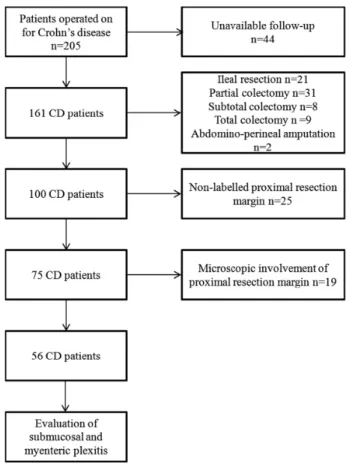HAL Id: hal-01607471
https://hal.archives-ouvertes.fr/hal-01607471
Submitted on 2 Jun 2020
HAL is a multi-disciplinary open access
archive for the deposit and dissemination of
sci-entific research documents, whether they are
pub-lished or not. The documents may come from
teaching and research institutions in France or
abroad, or from public or private research centers.
L’archive ouverte pluridisciplinaire HAL, est
destinée au dépôt et à la diffusion de documents
scientifiques de niveau recherche, publiés ou non,
émanant des établissements d’enseignement et de
recherche français ou étrangers, des laboratoires
publics ou privés.
Myenteric plexitis is a risk factor for endoscopic and
clinical postoperative recurrence after ileocolonic
resection in Crohn’s disease
S. Decousus, A-L Boucher, J. Joubert, Marion Goutte, F. Goutorbe, André
Dubois, B. Pereira, P. Dechelotte, Emmanuel Bommelaer, Anthony Buisson
To cite this version:
S. Decousus, A-L Boucher, J. Joubert, Marion Goutte, F. Goutorbe, et al.. Myenteric plexitis is a
risk factor for endoscopic and clinical postoperative recurrence after ileocolonic resection in Crohn’s
disease. 11. Congress of ECCO - European Crohn’s and Colitis Organisation, European Crohn´s
and Colitis Organisation (ECCO). INT., Mar 2016, Amsterdam, Netherlands. 1 p.,
�10.1093/ecco-jcc/jjw019.044�. �hal-01607471�
DOP015
Myenteric plexitis is a risk factor for endoscopic
and clinical postoperative recurrence after
ileocolonic resection in Crohn
’s disease
S. Decousus1, A.-L. Boucher2, J. Joubert1, M. Goutte2, 3, F. Goutorbe2,
A. Dubois4, B. Pereira5, P. Dechelotte1, G. Bommelaer2, 3, A. Buisson*2, 3
1University Hospital Estaing, Pathology Department, Clermont-Ferrand, France, 2University Hospital Estaing, Gastroenterology Department, Clermont-Ferrand, France, 3UMR 1071 Inserm/ Université d’Auvergne; USC-INRA 2018, Microbes, Intestine, Inflammation and Susceptibility of the host, Clermont-Ferrand, France, 4CHU Estaing, Department of Digestive surgery, Clermont-Ferrand, France, 5GM – Clermont-Ferrand University and Medical Centre, Biostatistics Unit, Clermont-Ferrand, France
Background: As surgical resection is not curative in Crohn’s disease
(CD), postoperative recurrence (POR) remains a crucial issue. The selection of patients according to available risk factors remains dis-appointing in clinical practice, highlighting the need for best criteria, such as histologic features. We aimed to investigate whether submu-cosal and myenteric plexitis increased the risk of endoscopic, clini-cal, and surgical POR in CD.
Methods: From the pathology department database, we
retrospec-tively retrieved the data of all the patients consecuretrospec-tively operated for CD in our centre. Inclusion criteria are presented in the study flow chart (Figure 1).
Two pathologists, blinded from clinical data, retrospectively reviewed all specimens to evaluate the presence of plexitis at the proximal resection margin. POR prevalence was determined using
the Kaplan–Meier method. Cox-proportional hazards regression was used in a multivariate situation by backwards and forwards stepwise analysis of the factors considered significant in univari-ate analysis (log-rank test) adding systematically the 5 risk factors according to ECCO guidelines: smoking, perianal lesions, previous intestinal resection, fistulising phenotype, and resection length > 50 cm. Results were expressed as hazard ratios (HR) and 95% con-fidence intervals (CI 95%).
Results: Of the 75 included CD patients, 19 (25.3%) had histological
involvement of resection margin, including 9 specimens with pres-ence of granuloma on the proximal resection margin. Inflammatory cells count for myenteric and submucosal plexus were performed in 56 patients. The prevalence of endoscopic, clinical, and surgical POR at 5 years was 69.0%, 61.6%, and 17.9%, respectively. In mul-tivariate analysis, the myenteric plexitis was the only risk factor for endoscopic POR (HR 8.83 CI 95% [1.6–48.6], p = 0.012), and the presence of at least 1 myenteric lymphocyte (HR 4.02 CI 95% [1.4– 11.2], p = 0.008) or one myenteric neutrophil (HR 23.0 CI 95% [3.3–160.4], p = 0.002) were predictive of clinical POR. Fistulising phenotype (B3 according to Montreal classification) was associated with increased risk of surgical POR (HR 4.29 CI 95% [1.0–18.9],
p = 0.05). We observed no histologic predictor for surgical POR.
Conclusions: Myenteric plexitis in proximal margins of ileocolonic
resection specimens is independently associated with endoscopic and clinical POR in CD. Myenteric plexitis research added to clinical risk factors could be very helpful to stratify patients according to their POR risk and should be encouraged in CD.
DOP016
Postoperative clinical recurrence is not different
in Crohn
’s disease patients classified as i2 on
the Rutgeerts score with lesions confined to
the ileocolonic anastomosis than in those with
lesions of the neoterminal ileum
P. Bayart*1, N. Duveau1, M. Nachury1, P. Zerbib1, R. Gerard1,
J. Branche1, V. Maunoury1, A. Boruchowicz2, M. Boualit2, J.-E.
Laberenne3, O. Manolache3, G. Pineton de Chambrun4, B. Pariente1
1CHRU de Lille, Lille, France, 2CH Valenciennes, Valenciennes, France, 3CH Seclin, Seclin, France, 4CHU Montpellier, Montpellier, France
Background: The Rutgeerts score, that comprises 5 grades of
sever-ity (i0–i4), is a suitable endoscopic model to predict clinical recur-rence after ileocolonic resection in Crohn’s disease (CD). Patients with i2 grade represent a particular population with an intermediate risk of clinical recurrence, and definition of i2 grade is heterogene-ous characterised by lesions confined to the ileocolonic anastomosis (i2a) or moderate lesions on the neoterminal ileum (i2b). The aim of the present study was to evaluate the probability of recurrence in i2a and i2b patients.
Methods: We performed a multicentre retrospective study,
includ-ing all CD patients who underwent curative ileocolonic resection and who were classified i2 according to the Rutgeerts score. The primary outcome was to evaluate the probability of clinical recur-rence in patients classified i2a and i2b. Secondary outcome was to evaluate the rate of global CD recurrence defined by clinical recur-rence and/or occurrecur-rence of radiological lesions, and/or worsening of endoscopic lesions, and/or optimisation of the medical treatment and/or new intestinal resection for CD.
Results: Included were 50 patients: 23 were classified i2a, and
27 were classified i2b. Demographic and clinical characteristics
Figure 1. Study flow chart explaining the selection of the included Crohn’s
disease patients.
